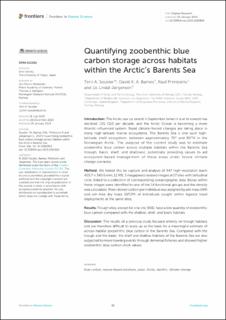| dc.contributor.author | Souster, Terri Ann | |
| dc.contributor.author | Barnes, David K. A. | |
| dc.contributor.author | Primicerio, Raul | |
| dc.contributor.author | Jørgensen, Lis Lindal | |
| dc.date.accessioned | 2024-03-06T11:18:32Z | |
| dc.date.available | 2024-03-06T11:18:32Z | |
| dc.date.created | 2024-02-23T12:12:30Z | |
| dc.date.issued | 2023 | |
| dc.identifier.citation | Frontiers in Marine Science. 2023, 10 . | en_US |
| dc.identifier.issn | 2296-7745 | |
| dc.identifier.uri | https://hdl.handle.net/11250/3121260 | |
| dc.description.abstract | The Arctic sea ice extent in September (when it is at its lowest) has declined 13% Q10 per decade, and the Arctic Ocean is becoming a more Atlantic-influenced system. Rapid climate-forced changes are taking place in many high-latitude marine ecosystems. The Barents Sea is one such high-latitude shelf ecosystem, between approximately 70° and 80°N in the Norwegian Arctic. The purpose of the current study was to estimate zoobenthic blue carbon across multiple habitats within the Barents Sea (trough, basin, shelf, and shallows), potentially providing values to aid ecosystem-based management of these areas under future climate change scenarios. | en_US |
| dc.language.iso | eng | en_US |
| dc.title | Quantifying zoobenthic blue carbon storage across habitats within the Arctic’s Barents Sea | en_US |
| dc.title.alternative | Quantifying zoobenthic blue carbon storage across habitats within the Arctic’s Barents Sea | en_US |
| dc.type | Peer reviewed | en_US |
| dc.type | Journal article | en_US |
| dc.description.version | publishedVersion | en_US |
| dc.source.pagenumber | 13 | en_US |
| dc.source.volume | 10 | en_US |
| dc.source.journal | Frontiers in Marine Science | en_US |
| dc.identifier.doi | 10.3389/fmars.2023.1260884 | |
| dc.identifier.cristin | 2249201 | |
| cristin.ispublished | true | |
| cristin.fulltext | original | |
| cristin.qualitycode | 1 | |
